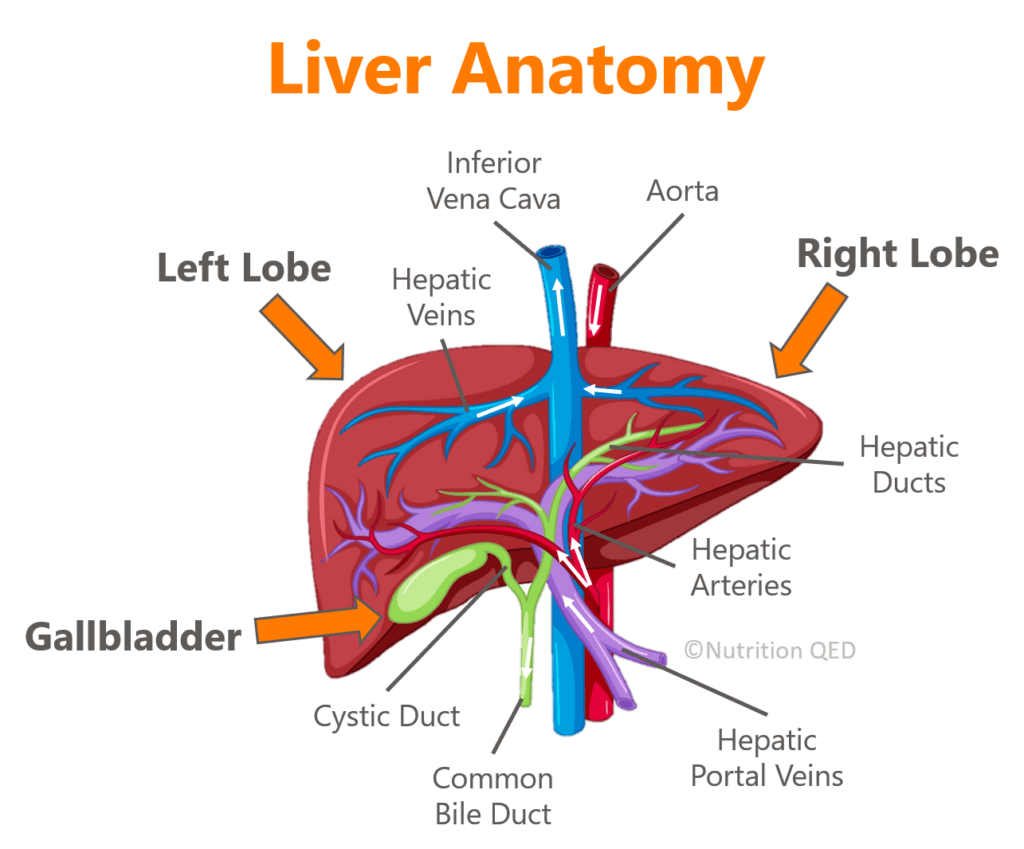Introduction
When was the last time you thought about your liver? For many, it only comes to mind when deciding which pain reliever to take or worrying about alcohol’s long-term effects. Yet, the liver is a powerhouse organ deserving of more recognition. This incredible organ not only detoxifies our bodies but also supports digestion, stores vital nutrients, and manufactures critical proteins. Without the liver’s 500-plus functions, life as we know it wouldn’t be possible.
Nestled beneath the rib cage on the right side of your abdomen, the liver is the largest internal organ, weighing around three pounds. In this introductory post, we’ll take a closer look at the anatomy, essential functions, and common ailments of the liver. This foundational knowledge will set the stage for deeper dives into topics like detoxification, alcohol’s impact, and fatty liver disease in future articles.
The Liver’s Anatomy
The liver is a reddish-brown, wedge-shaped organ that weight about 3 pounds (1.36 kg). It is located in the upper abdomen just below the diaphragm and above the other organs of the digestive system, with the small end above the stomach and the large end above the small intestine.

Lobes and Segments
The liver comprises two lobes, separated by the falciform ligament, and two smaller lobes on the underneath—the caudate and quadrate lobes. Each lobe is further divided into segments which are then made of thousands of lobules. These lobules have one duct each that transports bile from the liver to the gallbladder, where it’s stored until needed to digest fats in the small intestine.
Blood Supply
At any given moment, the liver holds about 13% of the body’s blood. It receives oxygenated blood via the hepatic artery and nutrient-rich blood from the digestive tract through the hepatic portal vein. After filtering toxins, the liver sends clean blood back to the heart via the hepatic veins and the inferior vena cava.
The Liver’s Main Functions
You may have wondered, “What does the liver do exactly?” While covering all 500+ functions of the liver would require a medical school textbook, here are 11 of its most critical roles:
- Bile production: Bile carries waste out of the body and helps digest dietary fats in the small intestine.
- Plasma protein manufacturing: Blood proteins, like albumin, help keep fluid in the circulatory system and transport hormones, vitamins, and enzymes throughout the body.
- Cholesterol, including LDL and HDL, and triglyceride creation: These blood-based fats carry dietary fat throughout the body, collect extra cholesterol from the bloodstream, and enable the storage of fat from excess calorie consumption.
- Glucose and glycogen conversion: Excess glucose is converted to glycogen for storage then back to glucose again when needed.
- Amino acid management: The body’s ability to build new proteins depends on healthy amounts of each amino acid being available.
- Vitamin and mineral storage: The liver is the main storage site for vitamins A, D, E, and K, as well as copper and iron.
- Bilirubin clearance: After the spleen breaks down worn out red blood cells, bilirubin carries the released iron to the liver for clearance from the body.
- Detoxification: Drugs, bacteria and other toxins, whether produced by the body or taken in via our digestive system, lungs, or skin, are removed by the liver.
- Ammonia conversion: When proteins are broken down in the body, toxic ammonia is created which must then be converted to urea for elimination in urine.
- Immunity support: When the immune system responds to injury or illness, the liver creates acute phase proteins that identify and destroy invaders, as well as regulating inflammation.
- Blood clotting: There are over a dozen blood clotting factors, most of which are produced by the liver, needed to heal an internal or external injury.
The Liver’s Ailments
Liver diseases, or hepatic diseases, arise from a range of causes, including infections, toxins, genetics, and lifestyle factors. Below are some of the most common conditions:
Fatty liver disease
Fatty liver disease is generally separated into two types: nonalcoholic fatty liver disease (NAFLD) and alcoholic fatty liver disease, depending on whether the damage can be linked directly to alcohol intake. In both types, extra fat builds up in the liver. If the excess fat causes liver cell damage or inflammation, it is called nonalcoholic steatohepatitis (NASH) or alcoholic steatohepatitis.
Alcoholic hepatitis
If alcoholic fatty liver disease progresses, alcoholic hepatitis may develop. Alcoholic hepatitis (AH) is a severe form of liver inflammation caused by excessive alcohol intake, often leading to hospitalization and high mortality rates..
Viral hepatitis
As the name suggests, viral hepatitis is liver inflammation and damage caused by a virus. Hepatitis A, B, C, D and E are caused by five different viruses. As well, human adenoviruses can cause hepatitis in immunocompromised individuals.
Hemochromatosis
Hemochromatosis is a genetic disorder that causes too much iron to be absorbed. As the body stores the excess iron in places such as the liver, heart, and pancreas, the organs gradually become overloaded and are damaged due to oxidative stress.
Bile duct diseases
Bile duct diseases are characterized by impeded or blocked flow of bile from the liver to the gallbladder or from the gallbladder to the small intestine, resulting in bile backing up into the liver and ultimately into the bloodstream. Gallstones, cholangiocarcinoma (cancer of the bile duct), strictures (scars in the bile ducts), primary sclerosing cholangitis, and primary biliary cholangitis are all forms of bile duct disease.
Wilson disease
A hereditary liver disease caused by mutations in the ATP7B gene, Wilson disease results in inadequate removal of copper from the body. Toxic levels of copper damage tissues and organs, especially the liver and brain.
Liver cancer
Hepatocellular carcinoma, intrahepatic cancer, and angiosarcoma are three distinct types of liver cancer, diagnosed based on where in the liver the cancer is located.
Cirrhosis
Characterized by irreversible scarring caused by continuous, long-term liver damage, cirrhosis is the end stage of all other liver diseases that have not been or cannot be treated.
Conclusion
The liver is a multitasking marvel, performing hundreds of critical functions to keep you alive and well. From filtering toxins and aiding digestion to storing nutrients and regulating blood clotting, it works tirelessly every day. Understanding its anatomy, functions, and vulnerabilities is the first step in appreciating its vital role in your health.
Stay tuned for the next post in this series, where we’ll explore the liver’s role in detoxification and how you can support its health through diet and lifestyle.
Image from Freepik.
Sources:
About hereditary hemochromatosis. (May 15, 2024). Hereditary Hemochromatosis. https://www.cdc.gov/hereditary-hemochromatosis/about/index.html
Barmore W, Azad F, Stone WL. Physiology, Urea Cycle. [Updated May 8, 2023]. In: StatPearls [Internet]. Treasure Island (FL): StatPearls Publishing; 2024 Jan. Available from: https://www.ncbi.nlm.nih.gov/books/NBK513323/
Chayanupatkul M, Liangpunsakul S. Alcoholic hepatitis: a comprehensive review of pathogenesis and treatment. World J Gastroenterol. 2014 May 28;20(20):6279-86. doi: 10.3748/wjg.v20.i20.6279. PMID: 24876748; PMCID: PMC4033465.
Harvard Health. (May 17, 2024). Bile duct diseases. https://www.health.harvard.edu/a_to_z/bile-duct-diseases-a-to-z
Hemolytic Anemia | NHLBI, NIH. (March 24, 2022). NHLBI, NIH. https://www.nhlbi.nih.gov/health/anemia/hemolytic-anemia
Kalakonda A, Jenkins BA, John S. Physiology, Bilirubin. [Updated 2022 Sep 12]. In: StatPearls [Internet]. Treasure Island (FL): StatPearls Publishing; 2024 Jan-. Available from: https://www.ncbi.nlm.nih.gov/books/NBK470290/
Kao, C., Surjit, M., & Ranjith-Kumar, C. T. (2021). Editorial: Viral Hepatitis: Pathophysiology, Prevention, and Control. Frontiers in Cellular and Infection Microbiology, 11. https://doi.org/10.3389/fcimb.2021.633580
Liver: anatomy and functions. (November 19, 2019). Johns Hopkins Medicine. https://www.hopkinsmedicine.org/health/conditions-and-diseases/liver-anatomy-and-functions
Liver Cancer. (August 6, 2024). Cleveland Clinic. https://my.clevelandclinic.org/health/diseases/9418-liver-cancer
National Library of Medicine. (n.d.). Fatty liver disease. MedlinePlus. https://medlineplus.gov/fattyliverdisease.html
NHS inform. (May 29, 2023). Cirrhosis | NHS inform. NHS Inform. https://www.nhsinform.scot/illnesses-and-conditions/stomach-liver-and-gastrointestinal-tract/cirrhosis/
Robinson MW, Harmon C, O’Farrelly C. Liver immunology and its role in inflammation and homeostasis. Cell Mol Immunol. 2016 May;13(3):267-76. doi: 10.1038/cmi.2016.3. Epub 2016 Apr 11. PMID: 27063467; PMCID: PMC4856809.
Streiff, M. B. (2023, October 9). How blood clots. Merck Manual Consumer Version. https://www.merckmanuals.com/home/blood-disorders/blood-clotting-process/how-blood-clots
The liver and its functions. (n.d.). https://columbiasurgery.org/liver/liver-and-its-functions
The Truth About Triglycerides – Health Encyclopedia – University of Rochester Medical Center. (n.d.). https://www.urmc.rochester.edu/encyclopedia/content.aspx?contenttypeid=56&contentid=2967
Wilson disease: MedlinePlus Genetics. (n.d.). https://medlineplus.gov/genetics/condition/wilson-disease/




